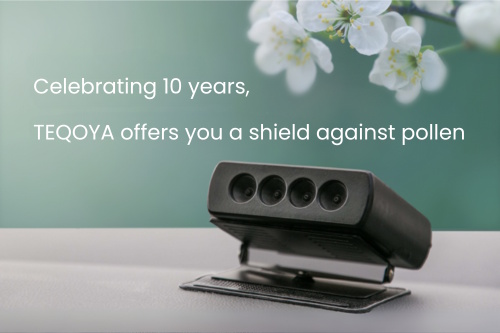Covid-19: several small air purifiers are better than one big one
Since the pandemic, with airborne transmission recognized as major, there has been an unprecedented wave of interest in air purifiers, which have been identified as a means of reducing the risk of COVID-19 transmission.
Classrooms ranked high on the list of potential locations for air purifiers. As a result, several studies were conducted to evaluate the effectiveness of air purifiers in this space, which is both large (about 50 m2) and highly populated (2 ti 3 m2 per person).
The risk of COVID-19 transmission can be reduced by 6 times depending on the cumulative filtration rate
By testing 3 to 4 air purifiers in a classroom, a study conducted by German researchers from the Goethe University of Frankfurt [1] showed the value of air purification in classrooms to limit the risk of COVID-19 transmission. In particular, they verified by measuring the validity of numerical models to quantify the diffusion of aerosols in a classroom.

The researchers conclude these results justify the use of "perfect mixing" models to evaluate the risk of COVID-19 transmission and infer that, with a high cumulative filtration rate of the purifiers (5 volumes per hour), the risk of transmission can be divided by 6. [1]
A study published by Harvard University as part of the American Healthy Building Program [2] confirms these findings. It also indicates that several purifiers may be more effective than one to treat large spaces.
The results of a simulation of COVID-19 airborne transmission
Based on these scientific foundations, TEQOYA, in partnership with the ALDES group, decided to conduct CFD (Computational Fluid Dynamics) simulations to represent a COVID-19 airborne transmission situation. The dispersion of aerosols emitted by an infected student in a classroom was calculated. The number of aerosols scattered in the classroom over time is used as an indicator of the exposure of other students (and the teacher) to the risk of infection.
The originality of this study lies in the use of ventilation: the classroom benefits from an air renewal of 200 m3/h by two ceiling vents. We represent a classroom in a modern building, equipped with a ventilation system that is properly sized.

Configurations compared sought to answer the following questions:
- What quantitative benefit do air purifiers provide in addition to ventilation?
- If we intuitively guess that distributing air purifiers in the room improves pollutant treatment, is this advantage significant compared to a single air cleaner of the same cumulative power?
- If yes, can the purified airflow rate be reduced to achieve the same efficiency as a larger single purifier (which reduces noise level and energy consumption)?
Results, summarized by the graph below, show that:
- the use of air purifiers significantly reduces the spread of aerosols in the air, including at a flow rate compatible with use in a classroom (noise level and air currents);
- three air purifiers distributed in a room are more effective than a single one in treating the same airflow rate.
Note that the effectiveness of the single air cleaner varies very strongly with its position relative to the infected person: the closer it's to the infected person, the higher the fraction of aerosols it can capture before they spread. This result may seem fairly obvious, as does the fact that it's impossible to predict the position of the infected person, and therein lies the essential benefit of distributing multiple air cleaners in the classroom.

In conclusion, if the previously cited studies show the high efficiency of air purification at high flow rates*, the study recently conducted by the ALDES group and TEQOYA is the first indication that a significant reduction in the risk of transmission of COVID-19 can be achieved by the use of air purifiers, even at a lower flow rate, in a realistic situation of the presence of air renewal (by mechanical ventilation or through open windows). It's also better to have several air purifiers rather than one big one.
*It takes about 700 m3/h to achieve a five volumes/hour rate for a medium-sized classroom.
Sources
[1] J. Curtius, M. Granzin & J. Schrod (2021) Testing mobile air purifiers in a school classroom: Reducing the airborne transmission risk for SARS-CoV-2, Aerosol Science and Technology, 55:5, 586-599, DOI: 10.1080/02786826.2021.1877257
[2] Salimifard P., Jones E., Allen J. “Portable Air Cleaners: Selection and Application Considerations for COVID-19 Risk Reduction.” Harvard T.H. Chan School of Public Health Healthy Buildings Program, August, 2020. DOI: 10.13140/RG.2.2.21494.63043.
Information on air quality and news from TEQOYA
How does an air ionizer work?
#Essential
Natural environments are rich in negative ions. This is precisely the principle on which the air ionizer is based on. However, do you know how this technology manages to capture the pollution particles contained in the indoor air to purify your home?
Are air purifiers effective against viruses, especially the coronavirus COVID-19
#Virus and microorganismes #L'essentiel
In December 2019, a respiratory virus of the Coronavirus family appeared in the Wuhan region of China and has now spread to all continents.
What is eco-responsibility?
#Essential
Purifying indoor air while protecting your health and the planet is possible! Say goodbye to filters and make way for negative ions: choose an eco-responsible air purifier that will easily reduce energy and resource consumption.

